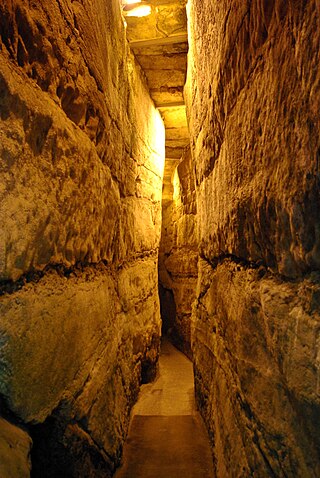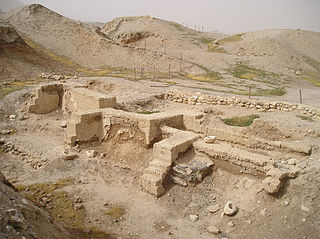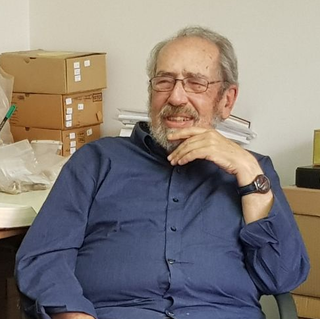
The Temple Mount, also known as Haram al-Sharif, al-Aqsa Mosque compound, or simply al-Aqsa, and sometimes as Jerusalem's holyesplanade, is a hill in the Old City of Jerusalem that has been venerated as a holy site for thousands of years, including in Judaism, Christianity and Islam.

The term Pool of Siloam refers to a number of rock-cut pools on the southern slope of the Wadi Hilweh, located outside the walls of the Old City of Jerusalem to the southeast. The pools were fed by the waters of the Gihon Spring, carried there by the Siloam Tunnel.

The City of David, known locally mostly as Wadi Hilweh, is the name given to an archaeological site considered by most scholars to be the original settlement core of Jerusalem during the Bronze and Iron Ages. It is situated on southern part of the eastern ridge of ancient Jerusalem, west of the Kidron Valley and east of the Tyropoeon Valley, to the immediate south of the Temple Mount.

Caesarea, also Caesarea Maritima, Caesarea Palaestinae or Caesarea Stratonis, was an ancient and medieval port city on the coast of the Eastern Mediterranean, and later a small fishing village. It was the capital of Roman Judaea, Syria Palaestina and Palaestina Prima, successively, for a period of c.650 years, and a major intellectual hub of the Mediterranean, from the time of Herod I until the Muslim conquest of the Levant. Today, the site is part of the Caesarea National Park, on the western edge of the Sharon plain in Israel.

The Old City of Jerusalem is a 0.9-square-kilometre (0.35 sq mi) walled area in East Jerusalem.

The archaeology of Israel is the study of the archaeology of the present-day Israel, stretching from prehistory through three millennia of documented history. The ancient Land of Israel was a geographical bridge between the political and cultural centers of Mesopotamia and Egypt.

Al-Musalla Al-Marwani, or Al-Marwani Mosque, is an underground vaulted prayer hall in the Al-Aqsa mosque compound in Jerusalem. It is 600 square yards in area, and is located under the southeastern corner of the compound, 12.5 m (41 ft) below the courtyard, and features twelve rows of pillars and arches. In December 1996 the Jerusalem Waqf renovated the area. The area was known to the Crusaders as Solomon's Stables, and to earlier Muslims as the Old Mosque.

The Western Wall Tunnel is a tunnel exposing the Western Wall slightly north from where the traditional, open-air prayer site ends and up to the Wall's northern end. Most of the tunnel is in continuation of the open-air Western Wall and is located under buildings of the Muslim Quarter of the Old City of Jerusalem. While the open-air portion of the Western Wall is approximately 60 metres (200 ft) long, the majority of its original length of 488 metres (1,601 ft) is hidden underground. The tunnel allows access to the remainder of the Wall in a northerly direction.

The Temple Mount, a holy site in the Old City of Jerusalem, also known as the al-Ḥaram al-Sharīf or Al-Aqsa, contains twelve gates. One of the gates, Bab as-Sarai, is currently closed to the public but was open under Ottoman rule. There are also six other sealed gates. This does not include the Gates of the Old City of Jerusalem which circumscribe the external walls except on the east side.

Levantine archaeology is the archaeological study of the Levant. It is also known as Syro-Palestinian archaeology or Palestinian archaeology. Besides its importance to the discipline of Biblical archaeology, the Levant is highly important when forming an understanding of the history of the earliest peoples of the Stone Age.

Gabriel Barkay is an Israeli archaeologist.

A number of archaeological excavations at the Temple Mount—a celebrated and contentious religious site in the Old City of Jerusalem—have taken place over the last 150 years. Excavations in the area represent one of the more sensitive areas of all archaeological excavations in Jerusalem.

The Temple Mount Sifting Project is an archaeological project begun in 2004 whose aim is the recovery and study of archaeological artifacts contained within debris which were removed from the Temple Mount in Jerusalem without proper archaeological care.

Temple denial is the claim that the successive Temples in Jerusalem either did not exist or they did exist but were not constructed on the site of the Temple Mount, a claim which has been advanced by Islamic political leaders, religious figures, intellectuals, and authors.

Ir David Foundation or City of David Foundation, commonly known as Elad [El'ad] is a Jerusalem-based, Israeli settler association which aims to strengthen the Jewish connection to Jerusalem, and renew the Jewish community in the City of David, which is also part of the neighborhood of Silwan. The foundation works to achieve its goals by tourism, education, archaeological excavations and obtaining homes in the area to establish a Jewish presence.

Zachi (Yitzhak) Dvira is an Israeli archaeologist. He co-directs the Temple Mount Sifting Project and was the first person to recognize the archaeological importance of the debris removed from Temple Mount. He initiated a project for systematic sifting of it.

Robinson's Arch is the name given to a monumental staircase carried by an unusually wide stone arch, which once stood at the southwestern corner of the Temple Mount. It was built as part of the expansion of the Second Temple initiated by Herod the Great at the end of the 1st century BCE. Recent findings suggest that it may not have been completed until at least 20 years after his death. The massive stone span was constructed along with the retaining walls of the Temple Mount. It carried traffic up from ancient Jerusalem's Lower Market area and over the Tyropoeon street to the Royal Stoa complex on the esplanade of the Mount. The overpass was destroyed during the First Jewish–Roman War, only a few decades after its completion.

The Southern Wall is the retaining wall of the Temple Mount at the southern end. It was built during King Herod's expansion of the Temple Mount platform southward on to the Ophel.

The Islamization of Jerusalem refers to the process through which Jerusalem and its Old City acquired an Islamic character and, eventually, a significant Muslim presence. The foundation for Jerusalem's Islamization was laid by the Muslim conquest of the Levant, and began shortly after the city was besieged and captured in 638 CE by the Rashidun Caliphate under Umar ibn al-Khattab, the second Rashidun caliph. The second wave of Islamization occurred after the fall of the Kingdom of Jerusalem, a Christian state that was established after the First Crusade, at the Battle of Hattin in 1187. The eventual fall of the Crusader states by 1291 led to a period of almost-uninterrupted Muslim rule that lasted for seven centuries, and a dominant Islamic culture was consolidated in the region during the Ayyubid, Mamluk and early Ottoman periods. Beginning in the late Ottoman era, Jerusalem’s demographics turned increasingly multicultural, and regained a Jewish-majority character during the late-19th and early-20th centuries that had not been seen since the Roman period, which largely ended the Jewish presence in the region.

Several kinds of archaeological remnants of the Jerusalem Temple exist. Those for what is customarily called Solomon's Temple are indirect and some are challenged. There is extensive physical evidence for the temple called the Second Temple that was built by returning exiles around 516 BCE and stood until its destruction by Rome in the year 70 CE. There is limited physical evidence of Solomon's Temple, although it is still widely accepted to have existed.




















